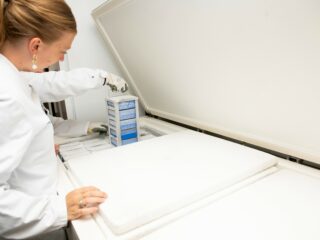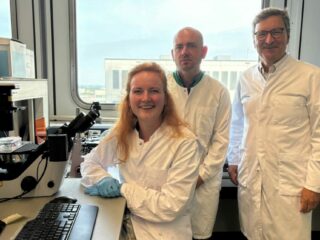The outlook for patients with triple-negative breast cancer is not good. Standard treatments often fail, and survival rates are low. PhD candidate Dian Kortleve, Dr. Dora Hammerl, and Prof. Dr. Reno Debets, head of the Tumor Immunology Laboratory in the Department of Medical Oncology, have spent the past eight years working on a new treatment, with promising results from laboratory studies. They published their findings in the scientific journal Cancer Discovery, a journal of the American Association for Cancer Research.
How do T-cells work again?
T-cells are white blood cells. They play an important part in maintaining a well-functioning immune system. For example, when a foreign microorganism enters the body, such as a virus, bacterium, or fungus, T-cells recognize these agents by certain proteins, also known as antigens or targets.
T-cells do this using receptors. There are billions of different T-cell receptors in our bodies. Only when an antigen binds to a specific receptor, is the number of T-cells with that receptor scaled up. T-cells with that receptor then attack the microorganisms and clear them. For cells that grow uncontrollably, such as tumour cells, recognition by T-cells is not different. Tumour cells are also recognized by their antigens.
‘Adoptive cell therapy’ is a new form of immunotherapy targeting cancer. T-cells from a patient are collected and genetically modified (provided with an antigen-specific receptor) to recognize the tumours. This so-called T-cell product is then given back to the patient. The T-cells find the tumours via the bloodstream, where they will activate to attack the tumour cells.
“This is a story with a clear beginning and end,” says Debets. That story began two decades ago. The laboratory was investigating a receptor that recognizes a target in renal cell cancer. When these T-cells were tested in patients, it was found that they also attacked the larger bile ducts. The clinical study had to be stopped.
It turned out that the target, besides being present on the tumour cells, is also expressed in tiny amounts on healthy bile ducts. The conclusion? “For T-cells, it doesn’t matter where the target is located in your body. The challenge is finding a target that is expressed by the tumour but not healthy organs.”
Ropporin-1
With a grant from the KWF Dutch Cancer Society, the researchers got to work. Hammerl started as a PhD candidate, and Kortleve joined later. They discovered ropporin-1, a protein that is expressed in 90 percent of triple-negative breast tumours. And, more importantly, in no other part of the body.
On to the next step: identifying a T-cell receptor that targets ropporin-1. The scientists searched among billions of natural receptors for one that specifically and sensitively recognizes ropporin-1. “It was like searching for a needle in a haystack,” according to Kortleve.
Tests
The team developed and streamlined a series of tests to isolate the right receptor and determine whether it was safe and effective. They found a T-cell receptor that recognizes ropporin-1 but does not recognize any other protein.
This T-cell receptor could also recognize 3D cultures of breast tumours from patients and breast tumours in mice. Hammerl: “Time and time again, T-cells targeting ropporin-1 outperformed standard treatments like chemotherapy.”
“Time and time again, T-cells targeting ropporin-1 outperformed standard treatments like chemotherapy.”
One of the final steps involved cultivating anti-ropporin-1 T-cells to make them suitable for a patient study. They did so successfully: also these T-cells were safely and effectively directed against breast tumours. Enough evidence, the researchers argued, to prepare a clinical trial in which the T-cell receptor will actually be tested in patients.
Clinical product
“Developing a clinical product, such as these anti-ropporin-1 T-cells, and testing it quickly in patients is an intensive and expensive process. It helps to have investors,” says Hammerl. In 2020, Pan Cancer T BV was founded, a spin-out from Erasmus MC, where she now works as Vice President of Discovery & Research.
The researchers have applied for a patent on the T-cell receptor. Erasmus MC has licensed this patent to Pan Cancer T. With additional funding rounds, Pan Cancer T is currently preparing for a clinical trial.
“The effectiveness of T-cell responses to the tumour in the patient cannot be predicted with certainty.”
So, what are the prospects? “In triple-negative breast tumours, ropporin-1 is expressed in almost all cases. However, for T-cells to recognize the target, the patient must also be positive for HLA-A2, a molecule that presents ropporin-1 to T-cell receptors. This molecule is present in about 45 percent of patients. In total, just under half of the patients with this tumour would be eligible for this potentially new therapy,” says Debets.
Effective
With their discovery, the researchers solve a major challenge: the lack of targets for triple-negative breast cancer. But there is a second challenge. Namely, tissue tumours, like breast tumours, actively inhibit T-cells.
“The effectiveness of T-cell responses to the tumor in the patient cannot be predicted with certainty, but our anticipations are high. Future strategies that make T-cells more resistant to inhibition by tumour cells will likely further enhance this form of T-cell therapy,” the researchers say.
Proud
“I am proud of this scientific discovery and the development of a new treatment option for breast cancer,” Debets concludes. “This would never have been possible without our team and the many collaborations, both within Erasmus MC, with Pan Cancer T BV, and with institutes like LACDR in Leiden, NKI in Amsterdam, and CHUV in Lausanne, Switzerland.”



